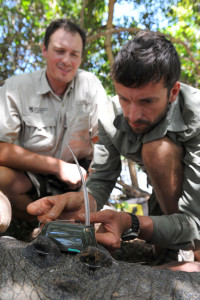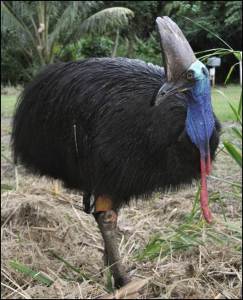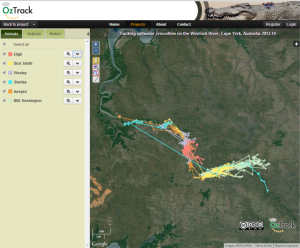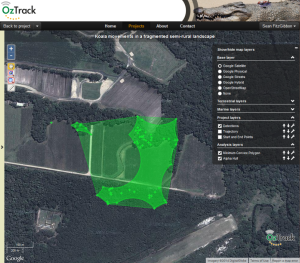
As ecological research continues to generate more and more data, the need for tools to store, synthesize and present this data is a pressing concern for ecologists. A paper published this week in Animal Biotelemetry is highlighting “OzTrack” – a suite of biotelemetry tools comprised of entirely open-source software. We spoke to authors Dr. Ross Dwyer and Dr. Hamish Campbell about the future of ecological data collection, and the increased need for open source tools capable of dealing with it.

What is biotelemetry and how is it a useful research tool in wildlife ecology?
A revolution is underway in the field of animal ecology. The advent of satellite-based animal telemetry and improvements in tag technology are enabling researchers to record observations from free-ranging animals with ever-increasing accuracy, precision and frequency. Miniaturisation, improvements in battery life and reductions in costs are allowing us to attach animal-borne electronic devices to a broader spectrum of species and to track their behaviors over much longer time periods. This has led to a proliferation of studies utilizing animal-borne devices, and across the globe many terrestrial, aquatic and aerial species have had their movements tracked using this technology.
As encountered in many other disciplines, such improvements in technology are resulting in datasets that are larger than off-the-shelf software tools or spreadsheet applications are able to manage. In addition to the challenging task of trapping wild animals and retrieving the devices, wildlife ecologists now also need to be skilled in additional software and computer programming to process, store, visualize and share these often vast datasets.

Can you briefly discuss OzTrack.org, what it is, what it does and who can use it?
In our recent paper published in Animal Biotelemetry we introduce a new online platform for archiving, visualising, analysing and distributing animal telemetry data: OzTrack. It provides robust, up-to-date and highly accessible tools for all steps of processing animal location data – including database and GIS functionality, and functions to examine movement rates, home range size and habitat use.
All analyses are carried out in R, underneath the easy-to-use Graphical User Interface. Users are provided access to a suite of powerful tools commonly used to analyse spatio-temporal datasets. The results of each analysis are displayed immediately onscreen, overlaid on a range of georeferenced base layers (GoogleMap and OpenStreetMap) or visualized environmental datasets obtained from online geospatial repositories such as elevation, dynamic land cover, bathymetry, sea surface temperature, salinity and existing terrestrial and marine protected areas.
To ensure that OzTrack remains freely-available to users, the system was developed using exclusively open-source software components. This means that no additional software, add-on packages or plugins are required to run the website, and the platform can be accessed from any computer or tablet with a Web browser.
How does this online tool benefit the science community and conservation?
The information we have gained from telemetry studies has greatly enhanced our current understanding of the biological requirements of animals in their natural environment. Such information is critical in the development of management strategies and conservation plans. The system we developed centralizes many of the processes required in telemetry data analysis, allowing raw, filtered and analysed data to be visualized and shared with high efficiency.

This reduces the need for data replication and export/import procedures across multiple software applications, which can be time consuming and prone to data duplication and error propagation.
OzTrack.org also provides a real-time collaborative environment where multiple users can log-in and access the same project simultaneously via configurable permissions and access rights. This combination of free and open tools, centralized infrastructure and a collaborative environment has been highlighted as a key requirement for more informed conclusions and management decisions.
Why is an open-access approach beneficial?
In developing OzTrack, our main objectives were two-fold. The first objective was to develop a free, online, open source, highly accessible yet comprehensive platform for processing animal location data. Our second objective was to increase data and metadata visibility, showing other researchers what data is already available and encouraging a data sharing culture amongst the animal tracking community.
OzTrack does this by enabling project owners to embargo their data for a period of up to three years. After this period, the data becomes visible but protected under a number of Creative Commons Licence agreements, ranging from fully open access with no copyright, to strict limitations on usage.

The sharing of the tracking data with the scientific community and general public can also be important in raising funds, promoting management decisions and increasing awareness of local conservation issues. Increased data transparency may also stimulate collaboration, through the sharing of data between research groups, and specialists in the same or related fields.
Since data is collected as a result of disturbing animals, and many programs are funded by public money, we would argue that there is a responsibility for researchers to provide public access to their data once funding and publishing obligations have been met.
How do you see this tool, and its uses, developing in the future?
New developments in tracking hardware, pressures for open access to data and the need for multidisciplinary collaborations are accelerating us towards a new age of ecological research. While the OzTrack system is still in its infancy, the observed uptake by the Australasian biotelemetry community suggests that the system is providing a valuable resource for researchers, wildlife managers and citizen scientists.
OzTrack was initially developed at The University of Queensland as part of a NeCTAR-funded collaboration between The University of Queensland’s School of Biological Sciences, the Environmental Decisions Group and the School of ITEE eResearch Lab. To boost platform sustainability, OzTrack has recently been integrated into the Atlas of Living Australia, the Australian node of the Global Biodiversity Information Facility (GBIF). This new collaboration will ensure the continued development and servicing of the system, enabling this facility to evolve in parallel with the telemetry devices and helping ensure the long-term legacy of existing animal location datasets.
For more information about OzTrack, or to upload your animal tracking data, visit our website at https://oztrack.org/.
Dr Ross Dwyer
Latest posts by Dr Ross Dwyer (see all)
- OzTrack – A new Open Source suite of tools for the budding biotelemetrist - 30th January 2015
Comments